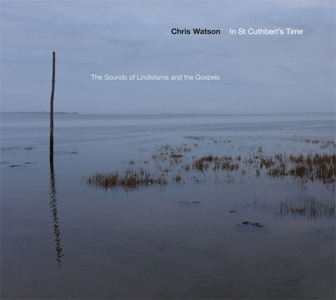Chris Watson, "In St. Cuthbert's Time"
 A distinctly different release than his last, El Tren Fantasma, this album not only acts as part of an overall larger project (a collaboration with faculty at Durham University), but also focuses on nature, rather than that disc’s use of man made transportation. Not just nature, but an attempt to capture the essence of of Lindisfarne Island as it would have sounded to St. Cuthbert in 700 AD. The result is an album that is a bit less compositionally oriented than El Tren Fantasma, but one that does an impeccable job at capturing a feel and an environment via audio.
A distinctly different release than his last, El Tren Fantasma, this album not only acts as part of an overall larger project (a collaboration with faculty at Durham University), but also focuses on nature, rather than that disc’s use of man made transportation. Not just nature, but an attempt to capture the essence of of Lindisfarne Island as it would have sounded to St. Cuthbert in 700 AD. The result is an album that is a bit less compositionally oriented than El Tren Fantasma, but one that does an impeccable job at capturing a feel and an environment via audio.
This disc is part of an exhibition of the Lindisfarne Gospels in England, and is intended to provide an audial context for the environment in which Eadfrith, the Bishop of Lindisfarne, was writing and illustrating the gospels that are being exhibited.Even disconnected from this context, the album is another example of Watson's unparalleled ability at capturing sound in a completely engrossing manner.
The album is broken up into four separate pieces, each titled for the season in which they were recorded.The vibrancy and activity of the recordings is closely tied to the time captured:the droning wind and infrequent bird calls of "Winter" are so much more cold and isolated than the aggressive avian flocks that permeate "Sumor."
Appropriately, both "Lencten" ("Spring") and "Haerfest" ("Autumn") sit somewhere between these two extremes in fauna and activity.The former captures the almost human like calls of land and water birds amidst a greater sense of life and vibrancy in comparison to the preceding piece."Haerfest" channels the bleakness of oncoming winter in its more muffled, darker sound.Gaggles of birds can be heard, likely migrating away to warmer climates while the vocalizations of seals and deer bring a bleaker, foreboding sense of the cold to come.
Surely the changes of climate have changed the environment that is the island of Lindisfarne from its medieval days, but Watson's recordings sound completely timeless, largely devoid of any human presence to solidify the isolation the Bishop experienced while completing the gospels.In fact, the only hint of humanity is the simple ringing of a hand bell towards the end of each piece, representing a call to prayer that would have been heard over 1300 years ago.
Watson's work definitely would make for an ideal accompaniment to the exhibition of the Lindisfarne Gospels, but even removed from that context it is a captivating, and beautifully captured disc of field recordings.It seems to be less of a composed work than some of Watson's other output, but even just a raw capturing of the environment makes for an amazing work.Again, there does not seem to be an environment that Watson cannot distill to its most fascinating sonic elements.
samples:
 



